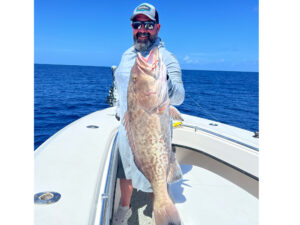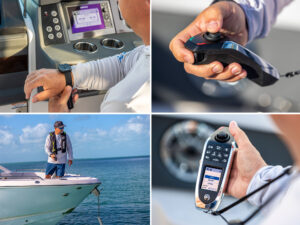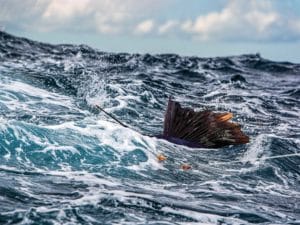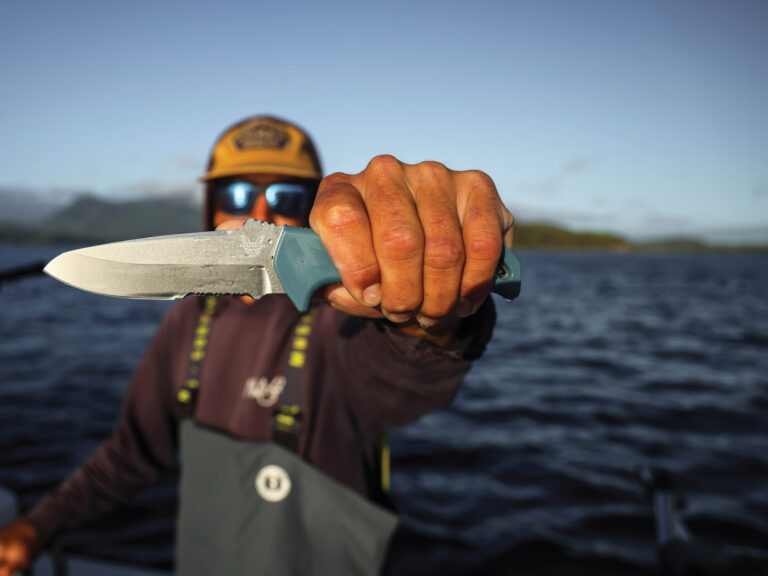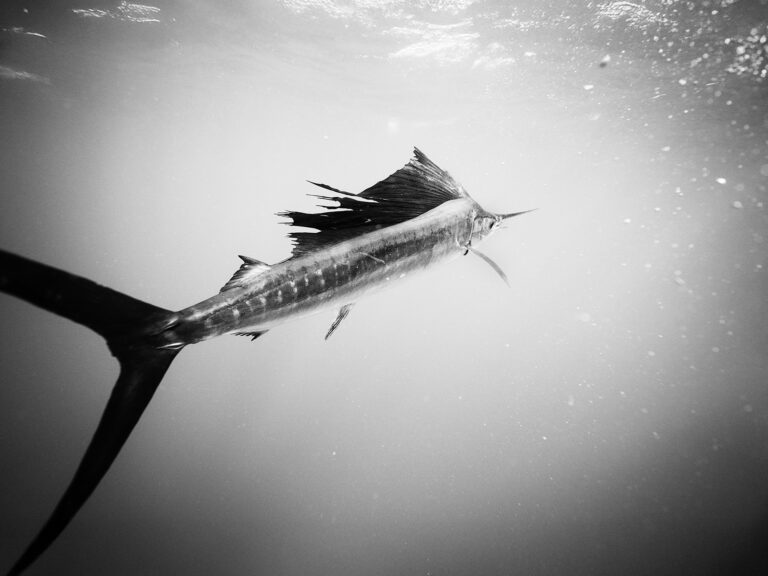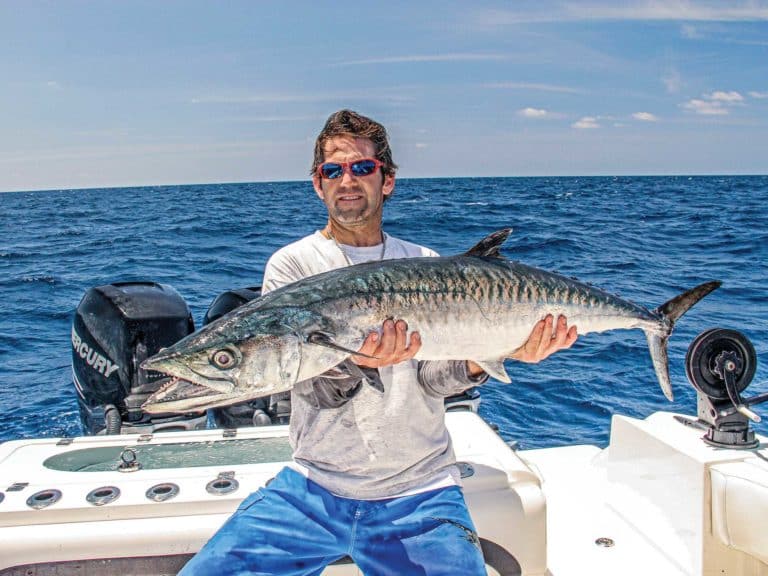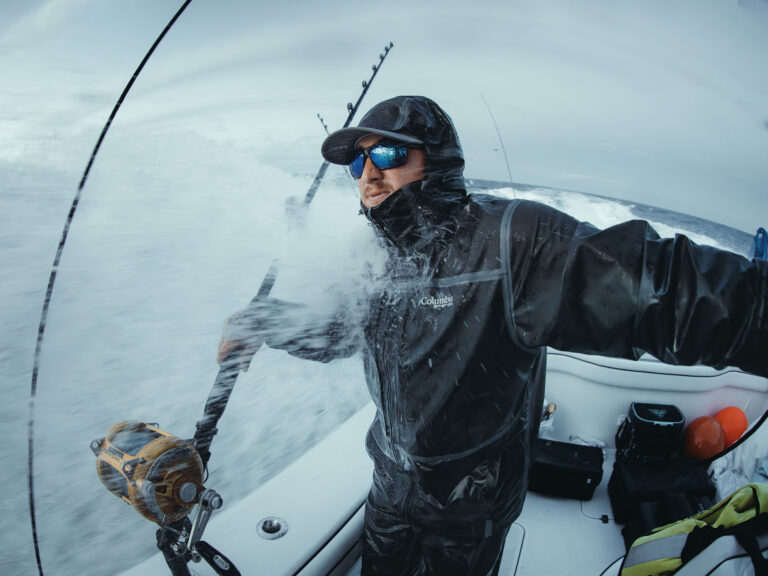
If you encountered a grizzly bear in the woods, would you dance and taunt the 700-pound man-eater? Well, trolling a high-speed lure past marlin, wahoo, tuna and dolphin is like poking the bear—it tempts predators to attack. But bluewater monsters aren’t mindless killers; the wrong color, flash or movement sends them swimming away. The latest offshore trolling lures push the line between audacity and temptation by splashing, sparkling, vibrating and bubbling to incite a wary predator into forgetting its prey is plastic, resin and steel.
Lure Trends
Anglers have been trolling artificial lures for pelagic predators for almost a century. The early pioneers turned boat epoxy, copper pipe, broom bristles and seashell fragments into functional pieces of fish-catching art. These cottage-made lures were beautiful but not durable.
Modern trolling lures improve durability with advanced materials and design. Andy Holcomb, partner at Fathom Offshore, says: “Marlin lures have evolved a great deal from the pill-bottle mold and strip-cut lawn-chair vinyl skirts of the ’70s and ’80s.” He points to ballistic-grade resins, UV-plus additives, keel weighting, jewelry-quality shell inserts and durable soft-plastic skirts. “Lure-makers are mixing the art of building lures with the absolute best in material advancements and technology,” he says.
The latest trend in offshore trolling is adding a high-speed, hard-bodied swimming plug to the spread. Chip Cone, director of marketing at Nomad Design, says: “Anglers are using swimming lures that can reach depths of up to 40 feet to catch a range of species.” Trolling lures are designed to dive to a specific depth without inline sinkers or planers. “These lures opened new opportunities in terms of what you can target and where you can fish,” Cone says.
The latest innovation in big-game trolling lures involves new “vibe” lures, which are small, heavy lures that create violent vibration. Yo-Zuri’s High Speed Vibe is less than 6 inches long, but it weighs almost 3 ounces.
Television host and world-traveling angler Capt. Carter Andrews appreciates the lure’s versatility. “If I’m on a tuna boil, I can cast the lure to breaking fish,” he says. When the tuna quit the surface and move deep, he lets the lure sink. “I can even troll the High Speed Vibe,” he says. The through-wire and 4x hooks with stainless hardware stand up to big fish.
A strange addition to the trolling-lure arsenal is the Nomad Squidtrex. Originally designed as a soft-bodied vibe lure, Nomad recently released huge models up to 21 ounces for high-speed trolling. Cone says: “The Squidtrex perfectly mimics a squid, has a great vibrating action, and the TPE (thermoplastic elastomer) is extremely durable.” The lure is infused with squid scent and includes a UV and glow finish to look and taste like a real squid.
Let’s Go Fishing
The biggest innovations in trolling lures are happening on the water. When the International Game Fish Association mandated circle hooks with natural baits in marlin tournaments, anglers switched to trolling lures and J hooks.
There are advantages to trolling lures over natural bait. Lures don’t require refrigeration and don’t wash out or fall apart. A good lure swims perfectly without spinning or snagging. More importantly, anglers troll lures at higher speed.
The advent of 360-degree sonar further encouraged the switch to lures. Instead of trolling around waiting for a fish to find the spread, lures allow a team to cover water while searching for fish with sonar.
Capt. Tom Peele, of Bangarang Sportfishing out of Wilmington, North Carolina, jokes: “All we do is put out five lures and drive around all day.” Peele runs streamlined lures on the long riggers and shotgun, and more animated lures in the short-rigger position. “If I miss a fish on the short rigger, it’s easier for the fish to follow up on the straight tracking lures,” he explains. The spread leaves plenty of space behind the transom for an angler to quickly deploy a natural pitch bait on a circle hook.”
Peele’s most recent discovery is a new tag-line system. To reduce the slack line between the rod tip and the lure, anglers use a fixed line from the outrigger halyard to the main line. Peele’s system replaces the longer fixed tag line with a 5-foot line and an AFTCO Roller Troller clip. “I tighten down the tension so I can use 18 pounds of drag on strike. The roller clip makes it easier to retrieve the lure to remove grass or adjust its position,” he says.
Artificial lures are also popular for high-speed trolling for wahoo. Capt. Matt Mauldwin, of the Gulf Breeze, Florida-based Click Through, trolls high-speed swimming plugs as he runs to the fishing grounds.
When Mauldwin slows the boat for fishing, he adds bullet-head lures to the long riggers, and an Ilander and ballyhoo to the center line. “Be sure to place one lure at the end of the prop wash—that’s the G-spot for wahoo,” he says. By mixing lipped swimming lures, lipless lures and weighted lures into the spread, Mauldwin covers the water column from the surface to 40 feet beneath the boat.
Read Next: How to Rig Plugs for Trolling

Hooking Up
Hooks are the Achilles’ heel of trolling lures. Unlike circle hooks that reliably lodge in the corner of the fish’s mouth, an artificial lure’s J hook must snag the speeding fish.
This causes a bunch of problems. First, lures often hook fish on the outside of the mouth. Poor hook placement increases the chance a hook will pull out.
Even if the hook finds a solid placement, the weight of a lure can work the hook loose as the fish shakes its head. “I’m doing good if I land 50 percent of the marlin I hook with lures,” Peele says.
To improve the odds, Frank Johnson at Mold Craft shared a simple hook-set design that keeps the fish connected. “The system dramatically improves hookup ratios,” he says. Johnson uses a simple single-hook twisted leader rig that places the hook bend at the back of the lure skirt. To prevent the J hook from backing out of the fish, he puts the hook in a vice and bends the hook point toward the shank. “I fish it like a circle hook, letting the fish take the bait while I drop-back,” he says.
Of all the advancements in lures, anglers are most excited about Sta-Stuk hooks. These hooks feature a hook shank with three interlocked welded rings in a metal sleeve. When the fish bites, the hook and leader are stiff to drive the hook home.
After the fish is hooked, the metal sleeves break away, exposing the interlocked rings so the hook swings free of the lure. This prevents the stiff leader and hook shaft from working as a lever to pull the hook out of the fish. Mauldwin says: “Testing proves the system increases the ratio of hookups to release to 75 percent.”
While there is a lot of art and science in trolling lures, experts agree fishing lures and swimming plugs is far simpler than natural bait. For small-boat anglers targeting wahoo, dolphin or blue marlin, lures offer an easy way to cover water and target big fish without dealing with rigging and maintaining natural-bait presentations.

